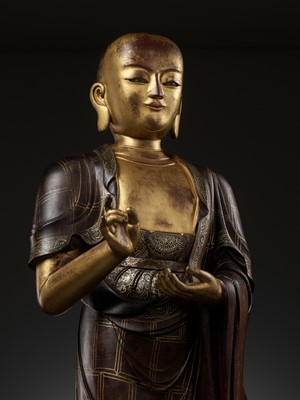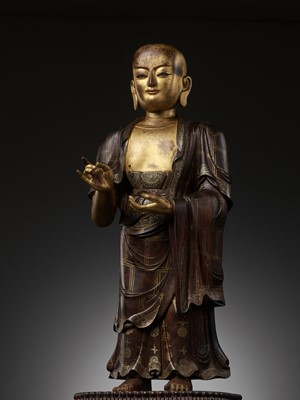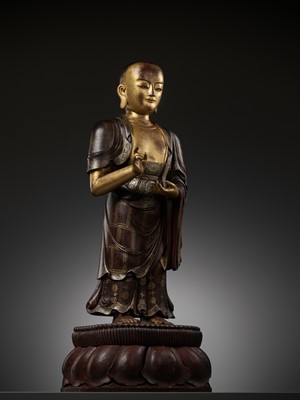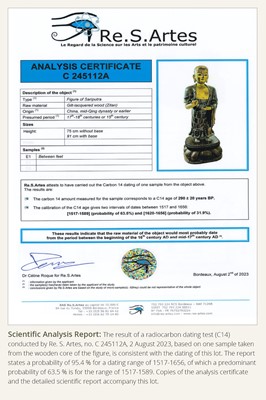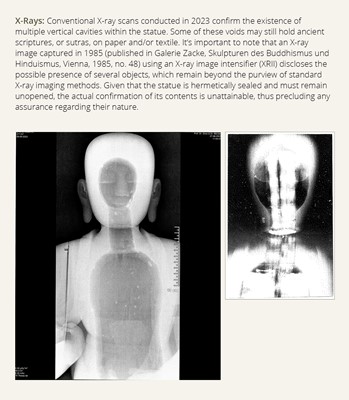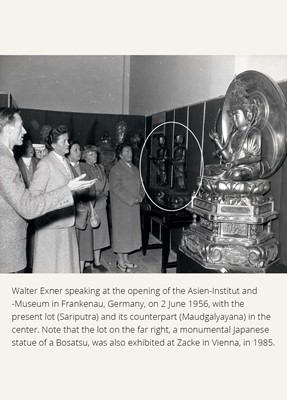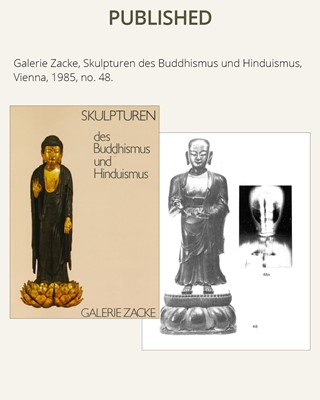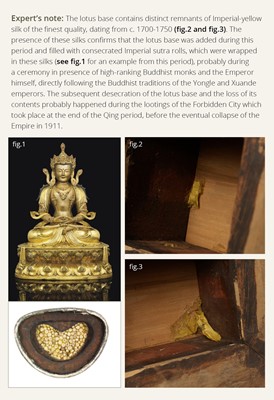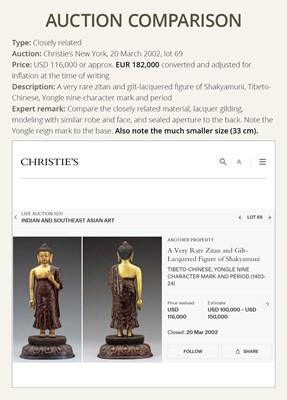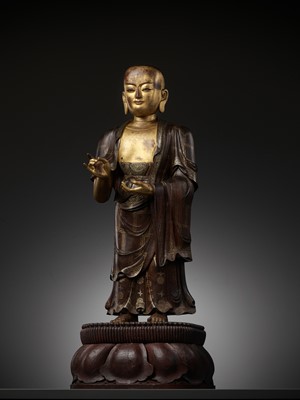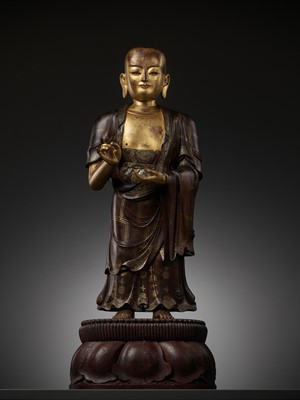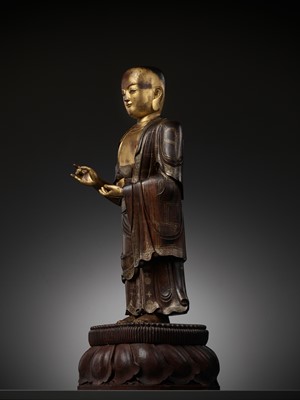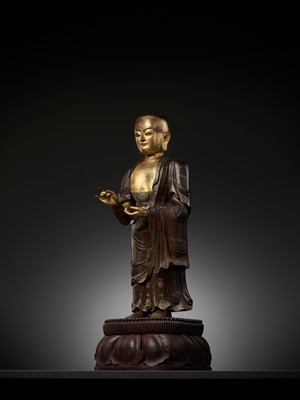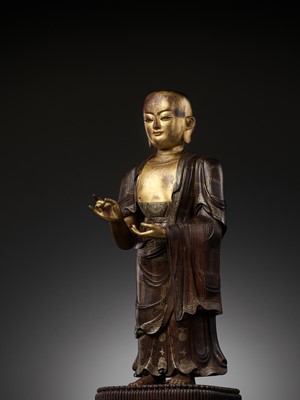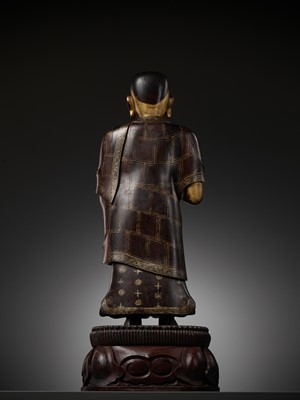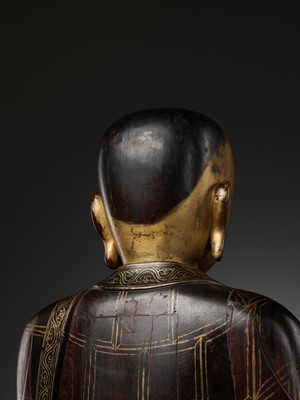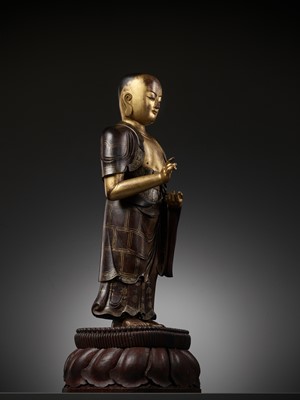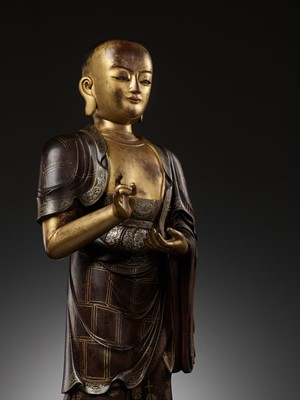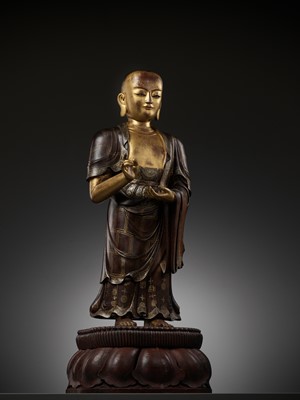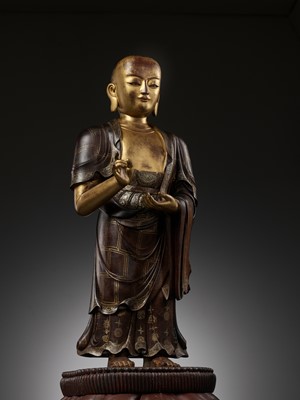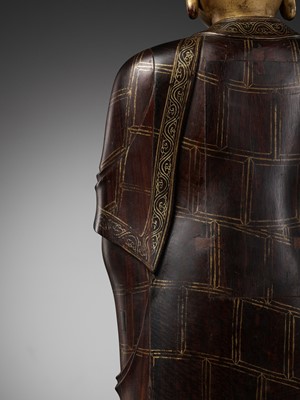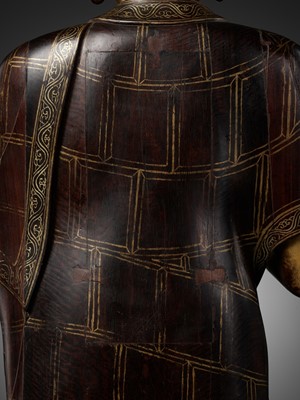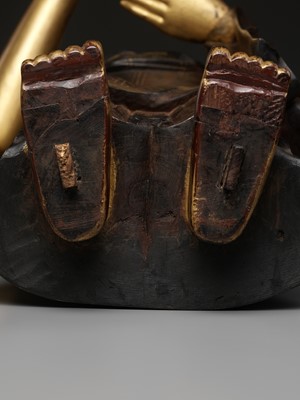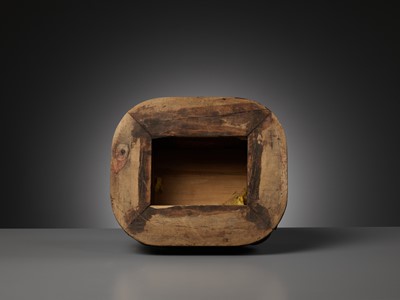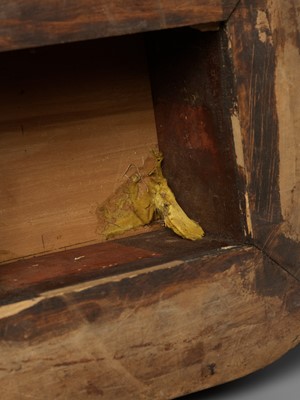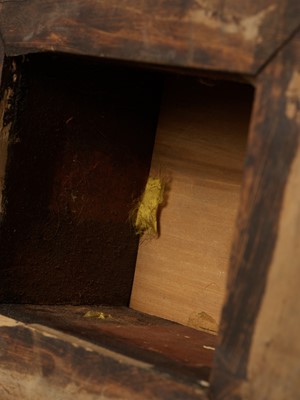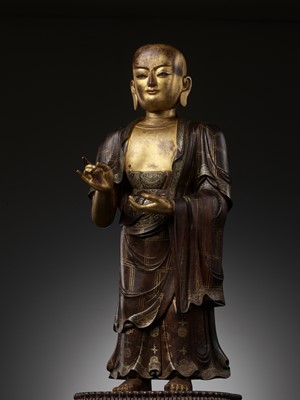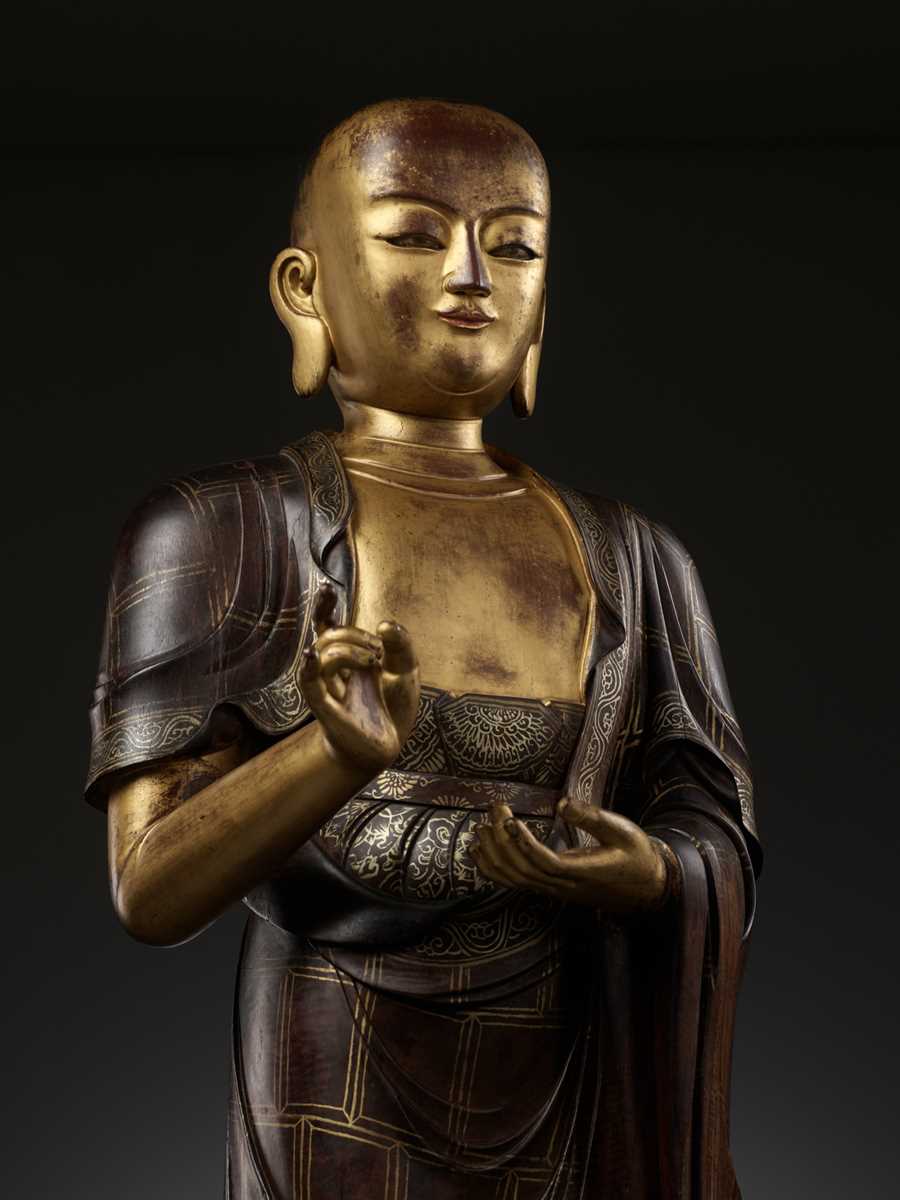11th Oct, 2023 11:00
THREE-DAY AUCTION - Fine Chinese Art / 中國藝術集珍 / Buddhism & Hinduism
187
Ɏ A LARGE AND HIGHLY IMPORTANT ZITAN AND GILT-LACQUERED STATUE OF SARIPUTRA, THE FIRST OF BUDDHA'S TWO CHIEF DISCIPLES, CHINA, 1520-1580
中國1520-1580年大型紫檀雕金漆舍利弗立像
Sold for €169,000
including Buyer's Premium
The Ming dynasty's largest surviving Zitan sculpture.
Scientific Analysis Report: The result of a radiocarbon dating test (C14) conducted by Re. S. Artes, no. C 245112A, 2 August 2023, based on one sample taken from the wooden core of the figure, is consistent with the dating of this lot. The report states a probability of 95.4 % for a dating range of 1517-1656, of which a predominant probability of 63.5 % is for the range of 1517-1589. Copies of the analysis certificate and the detailed scientific report accompany this lot.
X-Rays: Conventional X-ray scans conducted in 2023 confirm the existence of multiple vertical cavities within the statue. Some of these voids may still hold ancient scriptures, or sutras, on paper and/or textile. It's important to note that an X-ray image captured in 1985 (published in Galerie Zacke, Skulpturen des Buddhismus und Hinduismus, Vienna, 1985, no. 48) using an X-ray image intensifier (XRII) discloses the possible presence of several objects, which remain beyond the purview of standard X-ray imaging methods. Given that the statue is hermetically sealed and must remain unopened, the actual confirmation of its contents is unattainable, thus precluding any assurance regarding their nature.
The face and the exposed body are gilded overall. He is powerfully carved standing in samabhanga, his right hand held in karana mudra, and his left in dhyana mudra. His voluminous monastic robe is precisely carved with undulating folds and outlined in gold with patchwork, the hems similarly decorated with scroll and lozenge diaper, the undergarment with floral designs. His serene face shows heavy-lidded eyes, picked out in ancient pigments, gently arched brows, and bow-shaped lips forming a calm smile, flanked by pendulous earlobes, his short hair lacquered entirely black.
His back shows a rectangular aperture for consecration, and another to the back of his head, both sealed (see X-Ray section for more details).
The wood shows an attractive grain and elegant deep-red color, as expected from Zitan with a naturally grown patina, that is 500 years old.
The disciple stands on a finely carved, lacquered, and fitted wood pedestal decorated with overlapping lotus petals below a thickly beaded edge, dating from the 1700-1750 (see condition report and expert’s note for more details).
Condition: The statue is in superb condition, especially considering its high age of half a millennia and the rather sensitive Zitan wood. It is constructed of meticulously joined pieces of wood. Expected old wear, rubbing to gilt, and natural age cracks. Occasional light scratches, few minuscule chips. The original base is lost (see expert’s note) and was replaced between 1700 and 1750 with the present pedestal, which is in good condition with expected old wear, natural age cracks, minor flaking to lacquer and small losses.
Provenance:
- Collection of Anton Exner (1882-1952), Vienna, Austria, acquired in the Republic of China after the Xinhai Revolution of 1911
- Collection of Walter Exner (1911-2003), Bad Wildungen, Germany, acquired from the above after 1945
- Galerie Zacke, Vienna, Austria, acquired from the above and exhibited in 1985
- A noted private collection in Vienna, Austria
Anton Exner (1882-1952) was the most important dealer, collector, and assessor of East Asian art in Vienna during the interwar period. His collection included all branches of Asian art, from all epochs, and particularly Chinese and Japanese works. During a long sojourn through Canada and the USA from 1908 to 1910, he made first contacts with Chinese dealers and subsequently acquired numerous antiques at various Asian ports, which formed the basis for his future business activities. From then on, he went almost every year on buying trips to the Far East. The Austrian auction house Dorotheum appointed him as a sworn assessor of Asian art, a position he held for c. 25 years. From the early 1920s onwards, he lent objects to most major exhibitions of Asian art held in Austria, and eventually gifted a large part of his personal collection, numbering several thousand objects, to the Museum of Applied Arts in Vienna, where it is on permanent exhibition to this day.
Walter Exner (1911-2003), among other family members, inherited parts of the vast collection, which he had built together with his father from 1935 onwards, after their first joint trip to East Asia. He spent a year in Beijing from 1936 to 1937 and from 1956 to 1963, he directed the Asian Institute in Frankenau, Germany, which he founded, as well as its museum. The present lot was exhibited at the opening of this museum in June 1956. In 1965, Walter Exner moved the institute and the museum to Bad Wildungen, Germany. To fund the museum, he deaccessioned pieces from the collection until his passing in 2003.
Published:
Galerie Zacke, Skulpturen des Buddhismus und Hinduismus, Vienna, 1985, no. 48.
Exhibited:
Asien-Institut Frankenau, 1956-1963
Asien Institut Bad Wildungen, 1965-1977
Galerie Zacke, Vienna, 1985
Weight: 20.1 kg
Dimensions: Height 91 cm
Please click here to read the full description
Expert’s note:
Imperial Buddhist Zitan figures were made as early as the Yongle period, see the auction result comparison below for a good example. These statues were still rather small, but are already quite similar to the present lot. The only major difference is the size, and so it seems plausible that after the success of the smaller figures, larger ones were ordered by the emperor. In this context it is important to note that the radiocarbon dating of the present lot could reach back a further 50 years, well into the 15th century, when taking into account the usual deviations inherent to C14 measurements. Figures of Sadiputra and Maudgalyayana were never made without a statue of The Buddha at the center, which according to Buddhist protocol should have had between three and five times the size of the attendant figures. No Zitan Buddha statue of 2,7 meters or more is extant in China today, a fact that nurtures the theory that The Buddha was destroyed in a fire, possibly during the turmoil surrounding the Manchu seizure of Beijing in 1644. In this case the two disciple figures were saved from the fire, their bases left behind. It is well possible that these bases carried Imperial marks such as the statue in the auction result comparison.
The lotus base contains distinct remnants of Imperial-yellow silk of the finest quality, dating from c. 1700-1750. The presence of these silks confirms that the lotus base was added during this period and filled with consecrated Imperial sutra rolls, which were wrapped in these silks (see fig.1 for an example from this period), probably during a ceremony in presence of high-ranking Buddhist monks and the Emperor himself, directly following the Buddhist traditions of the Yongle and Xuande emperors. The subsequent desecration of the lotus base and the loss of its contents probably happened during the lootings of the Forbidden City which took place at the end of the Qing period, before the eventual collapse of the Empire in 1911.
The tradition of Buddhist statues carved from sandalwood originates in India, the prototype being the famous image purportedly commissioned during Buddha's lifetime by King Udayana. The Chinese monk Xuanzang returned from his pilgrimage to India in the 7th century with two highly prized Buddhist images carved from sandalwood. In the Tibetan context, the famous Nepalese sandalwood image of Arya-Avalokiteshvara at the Potala, tentatively dated 7th - 8th century, was copied numerous times in later periods, establishing a tradition of sandalwood carvings in Tibet, see Ulrich von Schroeder, Buddhist Sculptures in Tibet, 2001, volume II, cat. nos. 195 and 196.
Sariputra is considered the first of the Buddha's two chief male disciples, together with Maudgalyayana. Buddhist texts relate that the two were childhood friends who became spiritual wanderers in their youth. After having searched for spiritual truth with other contemporary teachers, they came into contact with the teachings of The Buddha and ordained as monks under him, after which The Buddha declared the friends his two chief disciples. In Buddhist art, Sadiputra is almost always depicted alongside The Buddha, usually to his right.
Gilt bronze was the preferred medium for Buddhist sculpture during the Ming dynasty, and the use of zitan is extremely rare. However, this 'purple sandalwood' with a characteristic grain of needle-like 'specks of gold' is the most highly prized wood in China and hence most befitting for Imperial use and worship. The high density of the wood makes this material especially suitable for fine and intricate carving. Due to its slow-growing nature, zitan was only available in small quantities. Much of the zitan that came to China was used for Imperial furniture, as the hard structure of the wood made it resistant to splitting and swelling in changes of climate. Lesser quantities were carved into small boxes, figures, stands and other scholars’ and literati accoutrement.
Exceedingly few Buddhist sculptures made from Zitan during the mid-Ming dynasty are known, and none of even remotely as spectacular a size as the present lot.
Literature comparison:
While there is remarkable consistency within the group of gilt bronze figures from the Yongle ateliers, the material here likely dictates somewhat more angular features. Thus compare the face of a gilt-bronze Yongle figure of Shakyamuni in the British Museum, see W. Zwalf (ed.), Buddhism, Art and Faith, 1985, cat. no. 305 and frontispiece page 2. For a related zitan and gilt-lacquered figure at the summer palace Jehol, where Emperor Qianlong had numerous small shrines made to house Buddhist sculptures of various origin and date, see The Chang Foundation, Taipei, Buddhist Art from Rehol, Tibetan Buddhist Images and Ritual Objects from the Qing Dynasty Summer Palace at Chengde, 1999, pl. 88, illustrating an 18th century gold lacquer shrine housing a figure of Buddha, possibly of Yongle date.
Auction result comparison:
Type: Closely related
Auction: Christie’s New York, 20 March 2002, lot 69
Price: USD 116,000 or approx. EUR 182,000 converted and adjusted for inflation at the time of writing
Description: A very rare zitan and gilt-lacquered figure of Shakyamuni, Tibeto-Chinese, Yongle nine-character mark and period
Expert remark: Compare the closely related material, lacquer gilding, modeling with similar robe and face, and sealed aperture to the back. Note the Yongle reign mark to the base. Also note the much smaller size (33 cm).
点此阅读中文翻译 (Chinese Translation)
中國1520-1580年大型紫檀雕金漆舍利弗立像
現存最大的明代紫檀雕塑。
舍利弗的臉部及身體鎏金,身體筆直站立。方頭圓頂,面相慈和,上身著覆雙肩式袈裟,下身著長裙,為標準的比丘形象。大耳垂肩,頸部蠶節紋三道。姿勢挺拔,其兩手皆置胸前,右手結卡拉納手印,左手結禪定手印。衣紋寫實自然,衣緣、袈裟及長裙上均刻畫花紋。他面部平靜安詳,雙眼微閉,眉毛輕輕拱起,弓形的嘴唇形成平靜的微笑,長耳垂,短髮全黑。
他的背部有一個用於奉獻的矩形孔,另一個位於他的後腦勺,兩者均被密封(有關更多詳細信息,請參閱 X 射線部分)。
木材呈現出迷人的紋理和優雅的深紅色,具有自然包漿,已有 500 年的歷史。
底座上飾有重疊的蓮花花瓣,邊緣下方有厚厚的串珠,可追溯至1700-1750 年(更多詳細信息,請參閱狀況報告和專家註釋)。
科學鑒定報告: Re. S. Artes 2023年 年 8 月 2 日所出具的放射性碳測年測試 (C14) 的報告,基於從佛像木芯上採集的一個樣本,與該拍品的年代一致。該報告指出,1517-1656 年間的概率為 95.4%,其中 1517-1589 年間的概率為 63.5%。 該批次附有分析證書和詳細科學報告的副本。
X 光:2023 年進行的 X 光掃描證實雕像內存在多個垂直空空心,其中可能仍保存著寫在紙質和/或紡織品的經文。而1985 年使用 X 光圖像增強器 (XRII) 拍攝的 X 光圖像(發表於 Galerie Zacke, Skulpturen des Buddhaus und Hinduismus,維也納,1985 年,第 48 期)也發現了可能存在的多個物體,這超出了標準X 光成像方法的範圍。由於雕像是密封的,且必須保持未打開狀態,因此無法對其內容進行確認。
品相:該雕像保存狀況極佳,它由精心連接的木塊製成。有磨損、鎏金摩擦和自然老化裂紋,局部有輕微劃痕,小缺口。原來的底座已丟失(參見專家註釋),目前的底座來自1700 年至1750 年,該底座狀況良好,有磨損、自然老化裂紋、輕微的漆面剝落和少量缺損。
來源:
奧地利維也納Anton Exner(1882-1952 年)收藏,1911 年辛亥革命後於中華民國獲得;德國巴特維爾東根Walter Exner (1911-2003) 收藏,1945年之後從上述收藏獲得;奧地利維也納Galerie Zacke藝廊,購於1985年並展出;奧地利維也納私人收藏。
Anton Exner (1882-1952) 是兩次世界大戰期間維也納最重要的東亞藝術經銷商、收藏家和顧問。他的收藏涵蓋了亞洲藝術的所有分支、各個時代,特別是中國和日本的作品。1908年至1910年,他在加拿大和美國旅居期間,首次與中國商人接觸,隨後在亞洲各個港口收購了大量古董,為他日後的商業發展奠定了基礎。 從那時起,他幾乎每年都會去遠東採購。 奧地利 Dorotheum 拍賣行任命他為亞洲藝術的宣誓評估員,他擔任該職位約 25年。從1920 年代初開始,他向在奧地利舉辦的很多大型亞洲藝術展出借藏品,並最終將他個人收藏的大部分(數千件物品)捐贈給維也納應用藝術博物館,展覽至今。
Walter Exner (1911-2003) 他和其他家庭成員繼承了數量龐大的藏品。這個收藏是他與父親自 1935 年第一次一起前往東亞旅行後共同建立的。1936年至1937年,他在北京呆了一年;1956年至1963年,他領導了他在德國弗蘭克瑙創辦的亞洲研究所及其博物館。目前的拍品在該博物館於 1956 年 6 月開幕時展出。1965 年,Walter Exner將研究所和博物館遷至德國巴特維爾東根 (Bad Wildungen)。 為了資助博物館,他出售了藏品。
出版:Galerie Zacke,Skulpturen des Buddhismus und Hinduismus,維也納,1985年,圖48。
展覽:
Asien-Institut Frankenau,1956-1963
Asien Institut Bad Wildungen,1965-1977
Galerie Zacke,Vienna,1985
重量:20.1 公斤
尺寸:高 91 厘米
專家注釋:
御用紫檀佛像早在永樂年間就已製作,下面的拍賣比較就是一個很好的例子。 這些雕像雖然還很小,但與現在的雕像相比已經很相似了。唯一的主要區別是尺寸。蓮花底座含有明顯的上等皇家黃色絲綢的殘餘物,其歷史可以追溯到公元 1700-1750年。這些絲綢的存在證實了蓮花底座是在這一時期添加的,並填充了開光的皇家經卷。這些經卷被包裹在這些絲綢中(參見圖1 的這一時期的例子),可能是在有高級官員在場的儀式上進行的。 而打開底座並取出其内容可能發生在清朝末期(1911 年清朝最終崩潰之前)對紫禁城的搶劫期間。
用紫檀雕刻佛像的傳統起源於印度,據說是佛陀在世時由烏達亞那國王委託製作的著名佛像。 七世紀,中國僧侶玄奘從印度朝聖歸來,帶著兩尊珍貴的紫檀佛像。在西藏布達拉宮著名的尼泊爾紫檀觀世音菩薩像(暫定為七至八世紀)曾被多次復制,從而在西藏出現了紫檀造像的傳統,參見Ulrich von Schroeder,《Buddhist Sculptures in Tibet》,2001 年,第二卷,圖195 和 196。
舍利弗是佛陀兩大弟子中的第一位,與目犍連並列。佛教文獻記載,兩人兒時是好友,在與其他導師一起尋求精神真理後,他們接觸到了佛法,並出家為僧。之後佛陀宣布這兩位朋友為他的兩大弟子。 在佛教藝術中,舍利弗幾乎總是出現在佛陀旁邊的右側。
明代佛教雕塑多以鎏金銅為主,紫檀的使用極為罕見。紫檀是中國最珍貴的木材之一,因此最適合皇家使用。木材的高密度使它特別適合精細複雜的雕刻。 由於紫檀生長緩慢,產量很少。傳入中國的紫檀大部分用於皇家家具,因為木材的堅硬結構使其能夠在氣候變化中抵抗開裂和膨脹。少量被雕刻成小盒子、人物、支架和其他學者和文人用品。
明代中期的紫檀佛像數量極少,規模也遠不如本拍品。
文獻比較:
雖然永樂作坊的這組鎏金銅人物像,具有顯著的一致性,但因為材料的緣由,讓雕像有更多棱角特徵。比較一件永樂鎏金釋迦牟尼佛像,收藏於大英博物館,參見 W. Zwalf (ed.),《Buddhism,Art and Faith》,1985年,圖錄編號305 和卷首頁2。一件相近的紫檀鎏金人物像,收藏於熱河夏宮,乾隆皇帝在那裡建造了許多小佛龕,用來存放不同來源和日期的佛教雕塑,請參閱台北張氏基金會,《Buddhist Art from Rehol,Tibetan Buddhist Images and Ritual Objects from the Qing Dynasty Summer Palace at Chengde》,1999年,圖版88,描繪了一座 18 世紀的金漆佛龕,內有一尊佛像,可能是永樂年間的。
拍賣比較:
形制:非常相近
拍賣:紐約佳士得,2002年3月20日,lot 69
價錢:USD 116,000(相當今日EUR 182,000)
描述:永樂款及年代紫檀鎏金釋迦牟尼像
專家註釋:比較非常相近的材料、鎏金、相似的長袍和面部,背面密封 。請注意底部永樂款。請注意尺寸較小 (33 厘米)。
The Ming dynasty's largest surviving Zitan sculpture.
Scientific Analysis Report: The result of a radiocarbon dating test (C14) conducted by Re. S. Artes, no. C 245112A, 2 August 2023, based on one sample taken from the wooden core of the figure, is consistent with the dating of this lot. The report states a probability of 95.4 % for a dating range of 1517-1656, of which a predominant probability of 63.5 % is for the range of 1517-1589. Copies of the analysis certificate and the detailed scientific report accompany this lot.
X-Rays: Conventional X-ray scans conducted in 2023 confirm the existence of multiple vertical cavities within the statue. Some of these voids may still hold ancient scriptures, or sutras, on paper and/or textile. It's important to note that an X-ray image captured in 1985 (published in Galerie Zacke, Skulpturen des Buddhismus und Hinduismus, Vienna, 1985, no. 48) using an X-ray image intensifier (XRII) discloses the possible presence of several objects, which remain beyond the purview of standard X-ray imaging methods. Given that the statue is hermetically sealed and must remain unopened, the actual confirmation of its contents is unattainable, thus precluding any assurance regarding their nature.
The face and the exposed body are gilded overall. He is powerfully carved standing in samabhanga, his right hand held in karana mudra, and his left in dhyana mudra. His voluminous monastic robe is precisely carved with undulating folds and outlined in gold with patchwork, the hems similarly decorated with scroll and lozenge diaper, the undergarment with floral designs. His serene face shows heavy-lidded eyes, picked out in ancient pigments, gently arched brows, and bow-shaped lips forming a calm smile, flanked by pendulous earlobes, his short hair lacquered entirely black.
His back shows a rectangular aperture for consecration, and another to the back of his head, both sealed (see X-Ray section for more details).
The wood shows an attractive grain and elegant deep-red color, as expected from Zitan with a naturally grown patina, that is 500 years old.
The disciple stands on a finely carved, lacquered, and fitted wood pedestal decorated with overlapping lotus petals below a thickly beaded edge, dating from the 1700-1750 (see condition report and expert’s note for more details).
Condition: The statue is in superb condition, especially considering its high age of half a millennia and the rather sensitive Zitan wood. It is constructed of meticulously joined pieces of wood. Expected old wear, rubbing to gilt, and natural age cracks. Occasional light scratches, few minuscule chips. The original base is lost (see expert’s note) and was replaced between 1700 and 1750 with the present pedestal, which is in good condition with expected old wear, natural age cracks, minor flaking to lacquer and small losses.
Provenance:
- Collection of Anton Exner (1882-1952), Vienna, Austria, acquired in the Republic of China after the Xinhai Revolution of 1911
- Collection of Walter Exner (1911-2003), Bad Wildungen, Germany, acquired from the above after 1945
- Galerie Zacke, Vienna, Austria, acquired from the above and exhibited in 1985
- A noted private collection in Vienna, Austria
Anton Exner (1882-1952) was the most important dealer, collector, and assessor of East Asian art in Vienna during the interwar period. His collection included all branches of Asian art, from all epochs, and particularly Chinese and Japanese works. During a long sojourn through Canada and the USA from 1908 to 1910, he made first contacts with Chinese dealers and subsequently acquired numerous antiques at various Asian ports, which formed the basis for his future business activities. From then on, he went almost every year on buying trips to the Far East. The Austrian auction house Dorotheum appointed him as a sworn assessor of Asian art, a position he held for c. 25 years. From the early 1920s onwards, he lent objects to most major exhibitions of Asian art held in Austria, and eventually gifted a large part of his personal collection, numbering several thousand objects, to the Museum of Applied Arts in Vienna, where it is on permanent exhibition to this day.
Walter Exner (1911-2003), among other family members, inherited parts of the vast collection, which he had built together with his father from 1935 onwards, after their first joint trip to East Asia. He spent a year in Beijing from 1936 to 1937 and from 1956 to 1963, he directed the Asian Institute in Frankenau, Germany, which he founded, as well as its museum. The present lot was exhibited at the opening of this museum in June 1956. In 1965, Walter Exner moved the institute and the museum to Bad Wildungen, Germany. To fund the museum, he deaccessioned pieces from the collection until his passing in 2003.
Published:
Galerie Zacke, Skulpturen des Buddhismus und Hinduismus, Vienna, 1985, no. 48.
Exhibited:
Asien-Institut Frankenau, 1956-1963
Asien Institut Bad Wildungen, 1965-1977
Galerie Zacke, Vienna, 1985
Weight: 20.1 kg
Dimensions: Height 91 cm
Please click here to read the full description
Expert’s note:
Imperial Buddhist Zitan figures were made as early as the Yongle period, see the auction result comparison below for a good example. These statues were still rather small, but are already quite similar to the present lot. The only major difference is the size, and so it seems plausible that after the success of the smaller figures, larger ones were ordered by the emperor. In this context it is important to note that the radiocarbon dating of the present lot could reach back a further 50 years, well into the 15th century, when taking into account the usual deviations inherent to C14 measurements. Figures of Sadiputra and Maudgalyayana were never made without a statue of The Buddha at the center, which according to Buddhist protocol should have had between three and five times the size of the attendant figures. No Zitan Buddha statue of 2,7 meters or more is extant in China today, a fact that nurtures the theory that The Buddha was destroyed in a fire, possibly during the turmoil surrounding the Manchu seizure of Beijing in 1644. In this case the two disciple figures were saved from the fire, their bases left behind. It is well possible that these bases carried Imperial marks such as the statue in the auction result comparison.
The lotus base contains distinct remnants of Imperial-yellow silk of the finest quality, dating from c. 1700-1750. The presence of these silks confirms that the lotus base was added during this period and filled with consecrated Imperial sutra rolls, which were wrapped in these silks (see fig.1 for an example from this period), probably during a ceremony in presence of high-ranking Buddhist monks and the Emperor himself, directly following the Buddhist traditions of the Yongle and Xuande emperors. The subsequent desecration of the lotus base and the loss of its contents probably happened during the lootings of the Forbidden City which took place at the end of the Qing period, before the eventual collapse of the Empire in 1911.
The tradition of Buddhist statues carved from sandalwood originates in India, the prototype being the famous image purportedly commissioned during Buddha's lifetime by King Udayana. The Chinese monk Xuanzang returned from his pilgrimage to India in the 7th century with two highly prized Buddhist images carved from sandalwood. In the Tibetan context, the famous Nepalese sandalwood image of Arya-Avalokiteshvara at the Potala, tentatively dated 7th - 8th century, was copied numerous times in later periods, establishing a tradition of sandalwood carvings in Tibet, see Ulrich von Schroeder, Buddhist Sculptures in Tibet, 2001, volume II, cat. nos. 195 and 196.
Sariputra is considered the first of the Buddha's two chief male disciples, together with Maudgalyayana. Buddhist texts relate that the two were childhood friends who became spiritual wanderers in their youth. After having searched for spiritual truth with other contemporary teachers, they came into contact with the teachings of The Buddha and ordained as monks under him, after which The Buddha declared the friends his two chief disciples. In Buddhist art, Sadiputra is almost always depicted alongside The Buddha, usually to his right.
Gilt bronze was the preferred medium for Buddhist sculpture during the Ming dynasty, and the use of zitan is extremely rare. However, this 'purple sandalwood' with a characteristic grain of needle-like 'specks of gold' is the most highly prized wood in China and hence most befitting for Imperial use and worship. The high density of the wood makes this material especially suitable for fine and intricate carving. Due to its slow-growing nature, zitan was only available in small quantities. Much of the zitan that came to China was used for Imperial furniture, as the hard structure of the wood made it resistant to splitting and swelling in changes of climate. Lesser quantities were carved into small boxes, figures, stands and other scholars’ and literati accoutrement.
Exceedingly few Buddhist sculptures made from Zitan during the mid-Ming dynasty are known, and none of even remotely as spectacular a size as the present lot.
Literature comparison:
While there is remarkable consistency within the group of gilt bronze figures from the Yongle ateliers, the material here likely dictates somewhat more angular features. Thus compare the face of a gilt-bronze Yongle figure of Shakyamuni in the British Museum, see W. Zwalf (ed.), Buddhism, Art and Faith, 1985, cat. no. 305 and frontispiece page 2. For a related zitan and gilt-lacquered figure at the summer palace Jehol, where Emperor Qianlong had numerous small shrines made to house Buddhist sculptures of various origin and date, see The Chang Foundation, Taipei, Buddhist Art from Rehol, Tibetan Buddhist Images and Ritual Objects from the Qing Dynasty Summer Palace at Chengde, 1999, pl. 88, illustrating an 18th century gold lacquer shrine housing a figure of Buddha, possibly of Yongle date.
Auction result comparison:
Type: Closely related
Auction: Christie’s New York, 20 March 2002, lot 69
Price: USD 116,000 or approx. EUR 182,000 converted and adjusted for inflation at the time of writing
Description: A very rare zitan and gilt-lacquered figure of Shakyamuni, Tibeto-Chinese, Yongle nine-character mark and period
Expert remark: Compare the closely related material, lacquer gilding, modeling with similar robe and face, and sealed aperture to the back. Note the Yongle reign mark to the base. Also note the much smaller size (33 cm).
点此阅读中文翻译 (Chinese Translation)
中國1520-1580年大型紫檀雕金漆舍利弗立像
現存最大的明代紫檀雕塑。
舍利弗的臉部及身體鎏金,身體筆直站立。方頭圓頂,面相慈和,上身著覆雙肩式袈裟,下身著長裙,為標準的比丘形象。大耳垂肩,頸部蠶節紋三道。姿勢挺拔,其兩手皆置胸前,右手結卡拉納手印,左手結禪定手印。衣紋寫實自然,衣緣、袈裟及長裙上均刻畫花紋。他面部平靜安詳,雙眼微閉,眉毛輕輕拱起,弓形的嘴唇形成平靜的微笑,長耳垂,短髮全黑。
他的背部有一個用於奉獻的矩形孔,另一個位於他的後腦勺,兩者均被密封(有關更多詳細信息,請參閱 X 射線部分)。
木材呈現出迷人的紋理和優雅的深紅色,具有自然包漿,已有 500 年的歷史。
底座上飾有重疊的蓮花花瓣,邊緣下方有厚厚的串珠,可追溯至1700-1750 年(更多詳細信息,請參閱狀況報告和專家註釋)。
科學鑒定報告: Re. S. Artes 2023年 年 8 月 2 日所出具的放射性碳測年測試 (C14) 的報告,基於從佛像木芯上採集的一個樣本,與該拍品的年代一致。該報告指出,1517-1656 年間的概率為 95.4%,其中 1517-1589 年間的概率為 63.5%。 該批次附有分析證書和詳細科學報告的副本。
X 光:2023 年進行的 X 光掃描證實雕像內存在多個垂直空空心,其中可能仍保存著寫在紙質和/或紡織品的經文。而1985 年使用 X 光圖像增強器 (XRII) 拍攝的 X 光圖像(發表於 Galerie Zacke, Skulpturen des Buddhaus und Hinduismus,維也納,1985 年,第 48 期)也發現了可能存在的多個物體,這超出了標準X 光成像方法的範圍。由於雕像是密封的,且必須保持未打開狀態,因此無法對其內容進行確認。
品相:該雕像保存狀況極佳,它由精心連接的木塊製成。有磨損、鎏金摩擦和自然老化裂紋,局部有輕微劃痕,小缺口。原來的底座已丟失(參見專家註釋),目前的底座來自1700 年至1750 年,該底座狀況良好,有磨損、自然老化裂紋、輕微的漆面剝落和少量缺損。
來源:
奧地利維也納Anton Exner(1882-1952 年)收藏,1911 年辛亥革命後於中華民國獲得;德國巴特維爾東根Walter Exner (1911-2003) 收藏,1945年之後從上述收藏獲得;奧地利維也納Galerie Zacke藝廊,購於1985年並展出;奧地利維也納私人收藏。
Anton Exner (1882-1952) 是兩次世界大戰期間維也納最重要的東亞藝術經銷商、收藏家和顧問。他的收藏涵蓋了亞洲藝術的所有分支、各個時代,特別是中國和日本的作品。1908年至1910年,他在加拿大和美國旅居期間,首次與中國商人接觸,隨後在亞洲各個港口收購了大量古董,為他日後的商業發展奠定了基礎。 從那時起,他幾乎每年都會去遠東採購。 奧地利 Dorotheum 拍賣行任命他為亞洲藝術的宣誓評估員,他擔任該職位約 25年。從1920 年代初開始,他向在奧地利舉辦的很多大型亞洲藝術展出借藏品,並最終將他個人收藏的大部分(數千件物品)捐贈給維也納應用藝術博物館,展覽至今。
Walter Exner (1911-2003) 他和其他家庭成員繼承了數量龐大的藏品。這個收藏是他與父親自 1935 年第一次一起前往東亞旅行後共同建立的。1936年至1937年,他在北京呆了一年;1956年至1963年,他領導了他在德國弗蘭克瑙創辦的亞洲研究所及其博物館。目前的拍品在該博物館於 1956 年 6 月開幕時展出。1965 年,Walter Exner將研究所和博物館遷至德國巴特維爾東根 (Bad Wildungen)。 為了資助博物館,他出售了藏品。
出版:Galerie Zacke,Skulpturen des Buddhismus und Hinduismus,維也納,1985年,圖48。
展覽:
Asien-Institut Frankenau,1956-1963
Asien Institut Bad Wildungen,1965-1977
Galerie Zacke,Vienna,1985
重量:20.1 公斤
尺寸:高 91 厘米
專家注釋:
御用紫檀佛像早在永樂年間就已製作,下面的拍賣比較就是一個很好的例子。 這些雕像雖然還很小,但與現在的雕像相比已經很相似了。唯一的主要區別是尺寸。蓮花底座含有明顯的上等皇家黃色絲綢的殘餘物,其歷史可以追溯到公元 1700-1750年。這些絲綢的存在證實了蓮花底座是在這一時期添加的,並填充了開光的皇家經卷。這些經卷被包裹在這些絲綢中(參見圖1 的這一時期的例子),可能是在有高級官員在場的儀式上進行的。 而打開底座並取出其内容可能發生在清朝末期(1911 年清朝最終崩潰之前)對紫禁城的搶劫期間。
用紫檀雕刻佛像的傳統起源於印度,據說是佛陀在世時由烏達亞那國王委託製作的著名佛像。 七世紀,中國僧侶玄奘從印度朝聖歸來,帶著兩尊珍貴的紫檀佛像。在西藏布達拉宮著名的尼泊爾紫檀觀世音菩薩像(暫定為七至八世紀)曾被多次復制,從而在西藏出現了紫檀造像的傳統,參見Ulrich von Schroeder,《Buddhist Sculptures in Tibet》,2001 年,第二卷,圖195 和 196。
舍利弗是佛陀兩大弟子中的第一位,與目犍連並列。佛教文獻記載,兩人兒時是好友,在與其他導師一起尋求精神真理後,他們接觸到了佛法,並出家為僧。之後佛陀宣布這兩位朋友為他的兩大弟子。 在佛教藝術中,舍利弗幾乎總是出現在佛陀旁邊的右側。
明代佛教雕塑多以鎏金銅為主,紫檀的使用極為罕見。紫檀是中國最珍貴的木材之一,因此最適合皇家使用。木材的高密度使它特別適合精細複雜的雕刻。 由於紫檀生長緩慢,產量很少。傳入中國的紫檀大部分用於皇家家具,因為木材的堅硬結構使其能夠在氣候變化中抵抗開裂和膨脹。少量被雕刻成小盒子、人物、支架和其他學者和文人用品。
明代中期的紫檀佛像數量極少,規模也遠不如本拍品。
文獻比較:
雖然永樂作坊的這組鎏金銅人物像,具有顯著的一致性,但因為材料的緣由,讓雕像有更多棱角特徵。比較一件永樂鎏金釋迦牟尼佛像,收藏於大英博物館,參見 W. Zwalf (ed.),《Buddhism,Art and Faith》,1985年,圖錄編號305 和卷首頁2。一件相近的紫檀鎏金人物像,收藏於熱河夏宮,乾隆皇帝在那裡建造了許多小佛龕,用來存放不同來源和日期的佛教雕塑,請參閱台北張氏基金會,《Buddhist Art from Rehol,Tibetan Buddhist Images and Ritual Objects from the Qing Dynasty Summer Palace at Chengde》,1999年,圖版88,描繪了一座 18 世紀的金漆佛龕,內有一尊佛像,可能是永樂年間的。
拍賣比較:
形制:非常相近
拍賣:紐約佳士得,2002年3月20日,lot 69
價錢:USD 116,000(相當今日EUR 182,000)
描述:永樂款及年代紫檀鎏金釋迦牟尼像
專家註釋:比較非常相近的材料、鎏金、相似的長袍和面部,背面密封 。請注意底部永樂款。請注意尺寸較小 (33 厘米)。
Zacke Live Online Bidding
Our online bidding platform makes it easier than ever to bid in our auctions! When you bid through our website, you can take advantage of our premium buyer's terms without incurring any additional online bidding surcharges.
To bid live online, you'll need to create an online account. Once your account is created and your identity is verified, you can register to bid in an auction up to 12 hours before the auction begins.
Intended Spend and Bid Limits
When you register to bid in an online auction, you will need to share your intended maximum spending budget for the auction. We will then review your intended spend and set a bid limit for you. Once you have pre-registered for a live online auction, you can see your intended spend and bid limit by going to 'Account Settings' and clicking on 'Live Bidding Registrations'.
Your bid limit will be the maximum amount you can bid during the auction. Your bid limit is for the hammer price and is not affected by the buyer’s premium and VAT. For example, if you have a bid limit of €1,000 and place two winning bids for €300 and €200, then you will only be able to bid €500 for the rest of the auction. If you try to place a bid that is higher than €500, you will not be able to do so.
Online Absentee and Telephone Bids
You can now leave absentee and telephone bids on our website!
Absentee Bidding
Once you've created an account and your identity is verified, you can leave your absentee bid directly on the lot page. We will contact you when your bids have been confirmed.
Telephone Bidding
Once you've created an account and your identity is verified, you can leave telephone bids online. We will contact you when your bids have been confirmed.
Classic Absentee and Telephone Bidding Form
You can still submit absentee and telephone bids by email or fax if you prefer. Simply fill out the Absentee Bidding/Telephone bidding form and return it to us by email at office@zacke.at or by fax at +43 (1) 532 04 52 20. You can download the PDF from our Upcoming Auctions page.
How-To Guides
How to Create Your Personal Zacke Account
How to Register to Bid on Zacke Live
How to Leave Absentee Bids Online
How to Leave Telephone Bids Online
中文版本的操作指南
创建新账号
注册Zacke Live在线直播竞拍(免平台费)
缺席投标和电话投标
Third-Party Bidding
We partner with best-in-class third-party partners to make it easy for you to bid online in the channel of your choice. Please note that if you bid with one of our third-party online partners, then there will be a live bidding surcharge on top of your final purchase price. You can find all of our fees here. Here's a full list of our third-party partners:
- 51 Bid Live
- EpaiLive
- ArtFoxLive
- Invaluable
- LiveAuctioneers
- the-saleroom
- lot-tissimo
- Drouot
Please note that we place different auctions on different platforms. For example, in general, we only place Chinese art auctions on 51 Bid Live.
Bidding in Person
You must register to bid in person and will be assigned a paddle at the auction. Please contact us at office@zacke.at or +43 (1) 532 04 52 for the latest local health and safety guidelines.
